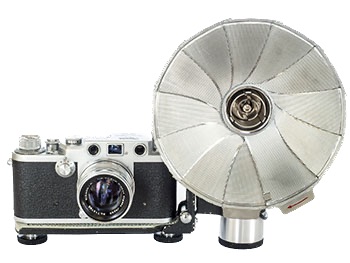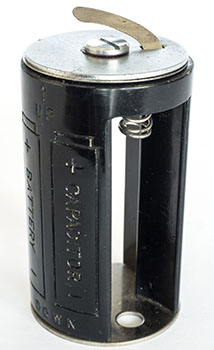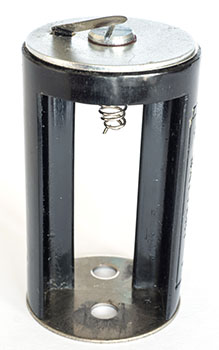Nicca's Flashgun Maker
The likely West Electric Co., Ltd. connection and shared DNA with the early Nikon Flashguns
Contents
(Scroll down or click on Links)
Did Nicca Make Its Own Flashguns?
West Electric Co., Ltd.
B.C.B. and BC Flashgun Types
The Direct Nicca/West Link
Nikon B.C.B. Flashgun Development
Comparison of Nicca B.C.B. and Nikon BCB-II
Fixed “L” Bracket
Mounting of “L” Bracket to Tube Mount
Tube Mount
Tubes
Flash Head
Battery/Capacitor Holders
Capacitors
Optional AA/Penlight Battery Holder
Comparison of Nicca BC-III and Nikon BC-3
Final Comment
Did Nicca Make Its Own Flashguns?
Whether the Nicca flashguns were produced by Nicca, or someone else, is not something that I have seen any discussion about and I can't absolutely definitively answer that one way or another, but I can go very close. What I have discovered is that there appears to be a strong link to “West” branded flashguns and that there are some surprising similarities to Nippon Kōgaku's early “Nikon” flashguns and we know who made those. West.
There are two sites that feature the early Nikon flashguns, MIR.com.my and http://nicovandijk.net and both provide excellent information but no clear indication that Nikon didn't develop its own, although the second site does say that;
“The following BC models are not all build by Nikon. Some have indicators of manufacturers of electronics like Sako (sic) and Toshiba.” (It's not clear whether this refers also to, or only to, the later compact fan fold reflector types.)
The official Nikon history site glosses over the development of the original Nikon B.C.B. flashgun but no lesser authority than the early 1950s Nippon Kōgaku (Nikon) itself told us that the second version of its flashgun, the BCB-II (and no doubt the B.C.B. from which it was developed and the later BC-3) was made by “West”. Below is part of a page from a Nippon Kōgaku Nikon S brochure downloadable in full from the Pacific Rim Camera site:
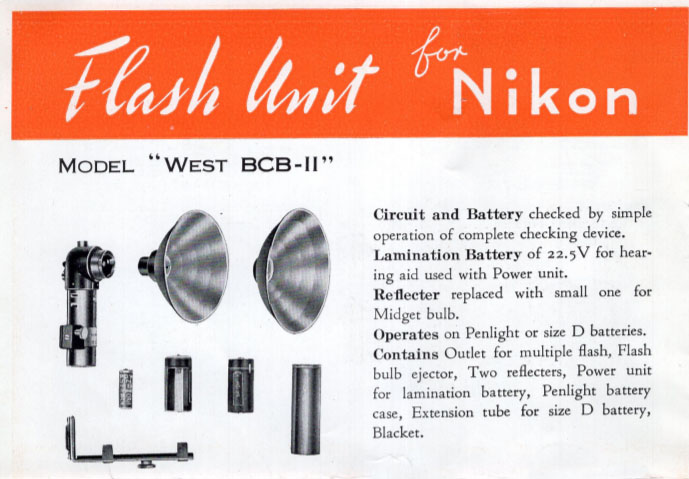
So we can take it for granted that West made the early Nikon models and therefore the main reason to compare Nikon to Nicca models is to further explore the Nicca-West connection.
Nicca's models are covered in detail in Flashguns on the Nicca page and any reference on this page will simply be for comparison purposes. To understand this page, it would be best to read about Nicca Flashguns first.
West Electric Co., Ltd.
“West” is West Electric Co., Ltd. which was based in Osaka, Japan. The company's history is not well known, but a Japanese blogger posted a brief summary from the history page of a Panasonic website. Unfortunately, Panasonic has since revised that page and omitted reference to West. This is the blogger's summary:
“Founded in 1947 (Showa 22) as West Vacuum Co., Ltd.
1948 (Showa 23) Started manufacturing and selling flash bulbs
1956 (Showa 31) Business partnership with Matsushita Electric Industrial Co., Ltd. (now Panasonic)
In 2006, the company name was changed to Panasonic Photo Lighting Co., Ltd.”
The earliest flashguns I have found are the three chrome tube handle type early Nicca-like examples featured further below, almost certainly all the same model, and a slightly later “West Miracle Power B-C Westo-Mat” which is similar to the later Nicca and Nikon models and probably the same as in a 1956 ad. There is also a more common, but probably later, compact shoe mounted folding reflector type called “West B.C.B. Miracle Power Flash Gun Type-O” (on the Minolta 35 page, I link this to the Minolta Junior B.C. Junior flash unit which seems to have been available from about 1956 to at least 1960). Still later models, probably from the beginning of the 1960s, are also compact types and seem to adopt the description “Hyper Flash” instead of the earlier “Miracle Power”.
However, West flash bulbs are listed in the Canon B-I Flash Unit user manual printed in December 1950 and in the guide number table on the back of the circa 1951 B-II Flash Unit. There are full page ads for various West branded flash bulbs in Asahi Camera magazines from 1952 to 1959 (the only date range I have access to), at least as many full page ads as, e.g. Toshiba. Although West flashbulbs are not mentioned in the 1950 Nikon S user manual (the first model equipped with flash sync), in the 1955 S2 manual (both are English language versions) they are the first brand listed in each situational example. Whilst not the first listed, they also appear in some Nicca English language user manuals. Considering my thoughts about the involvement of West, I was a little surprised to see a GE No. 5 flash bulb used as an example in the English version of the Nicca BC-III user manual but then I discovered that the Japanese manual substitutes a West No. 12 bulb. Below left is a typical West flash bulb ad in Asahi Camera, this one from 1954.
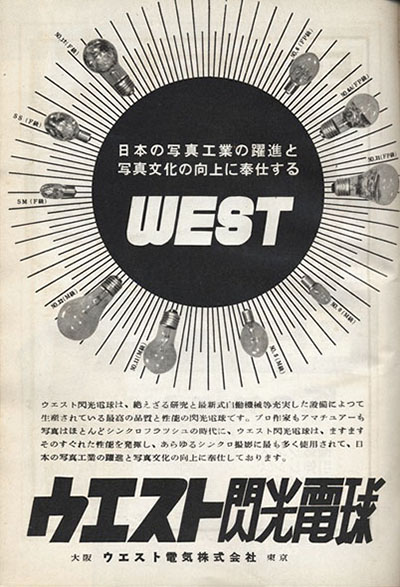
This is a packet of presumably earlier West class M 5B flash bulbs without any other branding than West:
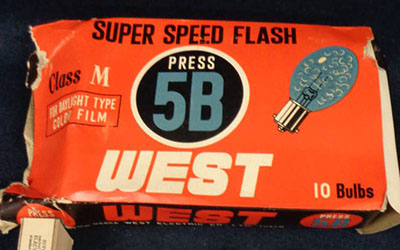 (Detail from larger web image)
(Detail from larger web image)
I have found a number of class M 5B flash bulbs with both a large “National” in Japanese and smaller “West Hyper Flash” in English on the packet top and the National logo on the side and on the internal packaging. Below is my similar packet of class FP 6 flash bulbs, the company name on the bottom of the packet is Matsushita:
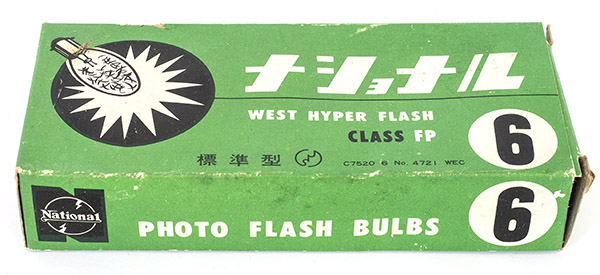
“National” is a Matsushita company brand name, as the blogger noted, these days called Panasonic Corporation. From at least the 1960s, National was a maker of flash units (the impressive 1978 Contax RTS540 electronic hammerhead flashgun was made for Yashica by National). One of its earlier efforts appears to be the compact folding reflector “National Hyper Flash Gun Model BII”. It's pretty much identical to the “West Hyper Flash Gun Model BII”. Similarly, there are “National Hyper D” and “West Hyper D” flashguns, both dynamo powered instead of by batteries and again, near identical. Interestingly, although not exactly the same, the BII and Hyper D models seem to correspond to the Yashica “Yashica-Lite BC-I” and “Yashica-Lite Dynamo-I” respectively with shared buttons, dials, dynamo wheels, metal trim and pivoting flash bulb adaptors. Below are two versions of the Hyper Flashgun Model BII, the first with West branding but with “Matsushita Electrical Industrial Co., Ltd.” in the Japanese fine print, the second with National branding:
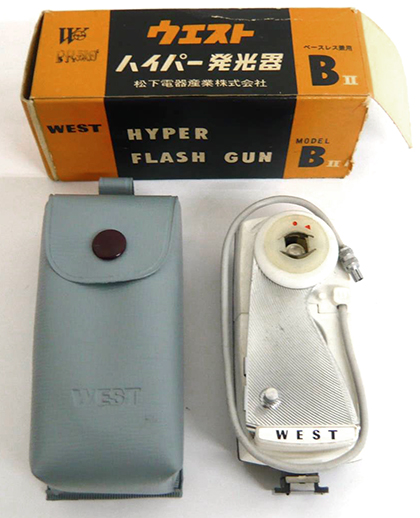

(Web images)
This is a West photoflood lamp. I can't put a date on it but it is described as “vintage” and I would guess late 1950s. At the bottom of the description on the back of the box, it says; “Manufactured by West Electric Co., Ltd. Distributed by Matsushita Electric Industrial Co., Ltd.”:
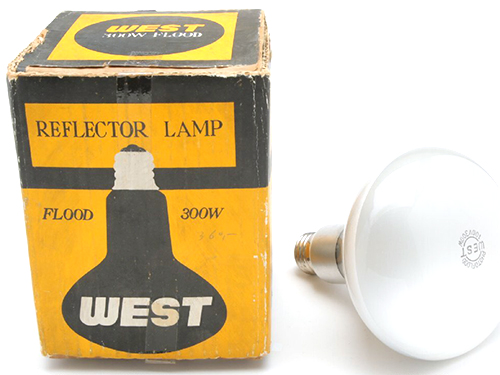
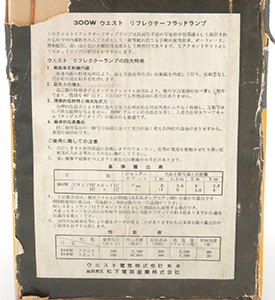
(Web images)
Confirming the blogger's claim above, obviously, there was a connection of some sort between West and National. Matsushita had commenced an aggressive 5 year expansion plan in 1956 and it seems that it either acquired West, or at least a significant interest in the company. In fact, in the fine print at the bottom of the 1958 and 1959 West ads in Asahi Camera referred to above, “Matsushita Electric Industrial Co., Ltd.” replaces the earlier “West Electric Co., Ltd.”, perhaps indicating ownership whilst maintaining the brand. 1958 ad:
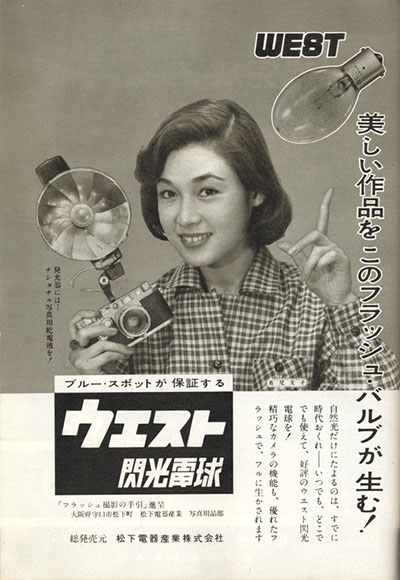
This packet of National flash bulbs is similar to the one above but no longer features any reference to West:
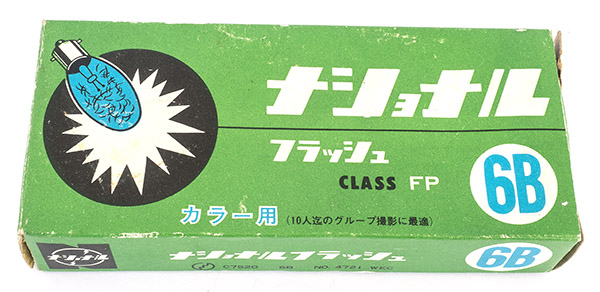
Nevertheless, there are quite a few flashgun patents assigned to West Electric Co., Ltd. of Osaka, Japan during the 1970s and 1980s, with at least two jointly assigned to “Matsushita Electric Industrial Co., Ltd., West Electric Company, Ltd.” US Patent Office references to West Electric Co., Ltd. flashgun patent applications continued into the 1990s. It was also listed as an exhibition supporter in the exhibition book “The Evolution of the Japanese Camera” by Condax et al, NY 1984. Therefore, whatever the relationship to Matsushita, wholly owned or not, it must have retained its identity and remained a player in the electronic flash era.
B.C.B. and BC Flashgun Types
This is another thing that we need to clear up first, mainly because whilst these names were both in common use by flashgun makers, similar Nicca, Nikon and West models align their common features with these names. There were the Nicca B.C./Nicca B.C. Model 2/Nicca B.C.B (all with B.C.B. engraving) and later BC-III models, the Nikon B.C.B., BCB-II (still engraved B.C.B.) and BC-3 and the West B.C.B. models. Note, for ease of discussion, from this point I'm going to lump all early Nicca Models with the B.C.B engraving under the name “Nicca B.C.B.”.
We know that “BC” (or “B-C” or “B.C”), where it appears in that context means “Battery Capacitor” but what does the “B.C.B.” abbreviation mean? Neither contributor Chris Whelan, nor myself, have managed to find a completely satisfactory explanation. I have seen it suggested that it means “Bayonet Cap Base” flashbulb (or “Bayonet Cap Bulb”). “Bayonet Cap”, also is commonly abbreviated to “BC”. The flashbulb was invented in 1928 with Edison Screw (ES) mount flashbulbs first appearing in the early 1930s and becoming popular with the press. The “miniature” BC type arrived in the late 1930s and by the early 1950s, BC types in smaller sizes were commonplace. The main problem with this claim is that the Nicca flashguns up to and including the BC-III and the Nikon flashguns up to and including the BC-3 can use either type of bulb.
Our own thinking is that B.C.B might mean “Battery Capacitor Battery ” to reflect that these early BC types could be powered by battery capacitor combination, or by batteries alone. Until about 1951, most flashguns used two, or more, 1.5 volt dry cell batteries in AA (then called penlight), C or D sizes. BC flashguns, which typically used a 22.5 volt (15 volt for some models) so-called “lamination” type battery to charge the capacitor, were introduced to provide a more reliable and efficient power source. However, some BC flashguns, can be operated with only batteries instead, but limitations apply and extra items, such as battery holders and/or extension tubes, may be necessary. The instruction manual for the earlier Nicca B.C.B. engraved models tells us that as well as the battery capacitor pack, they can be operated with D-cells (2 x min.), or AA batteries (3 x), with short tube extender (for total of 2 D cells) and side-by-side adaptor respectively included in the first red box kit. This is similar to instructions for the early Nikon B.C.B. models. A circa 1953 brochure for a compact Leotax B.C.B. flashgun makes it clear that it is designed as a battery capacitor type but if the the 22.5v battery is not available, the flash can be operated with 3 penlight cells.
The manual for the first Nikon B.C.B. flash, which used D-cell size components (explained later) tells us that a minimum of 4.5 volts, i.e. 3 D-cells, is required if using a shutter speed of 1/500 or when “more than two flashbulbs are consumed on the circuit” thereby implying that 3 volts is enough to achieve ignition in most common-use situations (it is actually the current that matters and 2 x D cells may be enough but with AAs, or penlights, 3 may be required). In fact, some early flashguns, such as the Nikon B.C.B. and the popular Minicam Synchron Junior, were sold without the battery/capacitor and offered the set as an accessory.
In support of our theory, neither the new Nicca BC-III, nor Nikon BC-3 (and later Nikon models), feature the “B.C.B.” name on their bodies, nor instructions, but neither do they provide the facility of operating on a battery pack only, i.e. without the battery option, the B.C.B. name was not used. Note, this is circumstantial evidence only and may well turn out to be just a coincidence.
Even though we can only guess the real meaning of “B.C.B.”, it is useful in linking Nicca and Nikon (and similar West examples below). It's possible that the term is unique to West and therefore it may even identify other brand, similar vintage, West sourced flashguns. Others that I have found are the aforementioned Leotax B.C.B. (its pedigree unknown) and a Minolta B.C.B. (I have a later circa 1956 Minolta Junior B.C. flash which shares several features with the contemporary West B.C.B. Miracle Power Flash Gun Type-O). There are also Anglo B.C.B. Miracle Power (identical to the West version) and Bower and Delta B.C.B. flashes which are clearly rebrands for distributors (the last two share familiar West fan-fold reflector details). Where the power source is known, or the power supply chamber is visible, all, including the Minolta Junior B.C., can be operated by battery and capacitor, or battery alone.
The Direct Nicca/West Link
First image below is the retail box for a “West Miracle Power B.C.B - S Flash Gun”. Second image is of still well wrapped and tightly packaged components that the box fits like a glove. The surprising inclusion is the “Directions for Using Nicca B.C.B. Flash Unit” with the “Nicca” crossed out and replaced by “West”. Third image is of the unwrapped tube unit, reflector and tube extension:
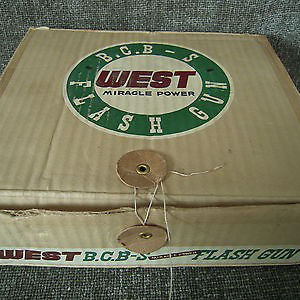
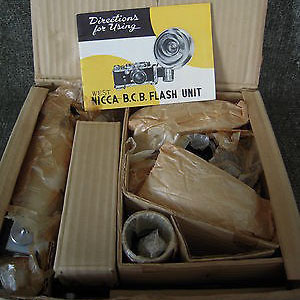

(Detail from larger web images)
The reflector and the black head unit complete with cast red “SHUTTER” between rectangular connector sockets certainly look like exact matches for the Nicca B.C.B. flashgun items. Noting that the extension tube is not fitted, the handle looks longer, perhaps indicated by the “S” in “B.C.B - S” on the box? To me it looks like the Nicca head with longer tube is designed for stacked D-cell size power components i.e., capacitor and 22.5 volt battery or two 1.5 volt D-cells, or with extension, three 1.5 volt D-cells. That is similar to the original Nikon B.C.B. design. The bracket connector mount is also different, rather simpler. Perhaps this version was designed for a typically taller camera, a 120 folder or TLR. In a separate completed auction, the bracket connector mount below was offered either by itself, or part of a flashgun unit, but unfortunately no other photos remain. It is low resolution but “WEST BCB” is clear and it looks similar to the one fitted above and is certainly intended for a similar style flashgun:
 (Detail from larger web image)
(Detail from larger web image)
I have also found low resolution photos of another flashgun with the same flash head, reflector and bracket connector mount as above with extension tube mounted and described as “West B.C.B. 3 cell flash” (the camera bracket is shown mounted to the bracket connector for storage):
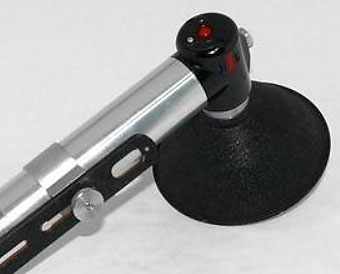 (Detail from larger web image)
(Detail from larger web image)
For comparison, Nicca B.C.B. below, ignore the tube length and mount. Note a test bulb is installed, pushing the red eject button out from the body.
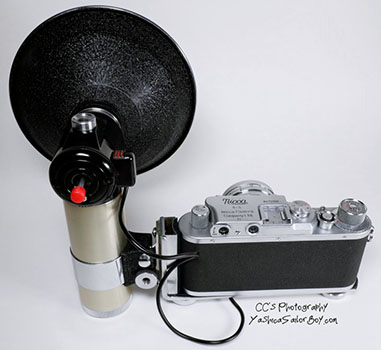
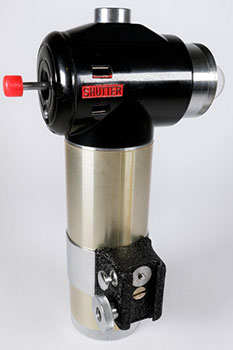
(Images courtesy of Chris Whelan)
None of my photos give a completely comparable picture but seeing them altogether (i.e., quite a few more than shown here) makes it much more obvious.
Below is an Asahi Camera ad from 1956 featuring a West handle flash which seems to use an “L” bracket mount to tube mount different to the West example above, the Nicca or the Nikon types. Although the mount on the flashgun looks more like the Nicca and Nikon cast type rather than the West one above, it uses a large thumbscrew to attach the bracket to the flashgun mount instead of the more sophisticated quick action slide-on of the Nicca and Nikon, but in other respects, there are similarities to the later Nicca BC-III and Nikon BC-3 flashguns:
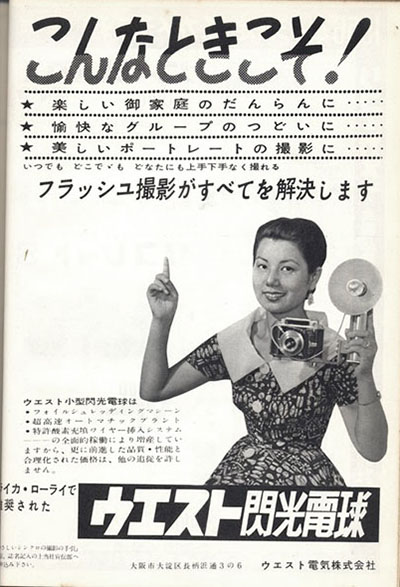
Whilst it's body tube appears longer, perhaps for D cell size components, in other respects, it looks the same as this “West Miracle Power B-C Westo-Mat” flashgun set:
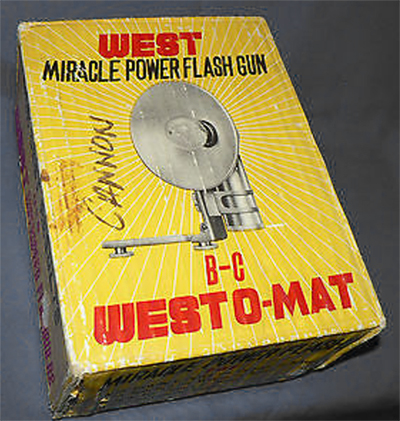
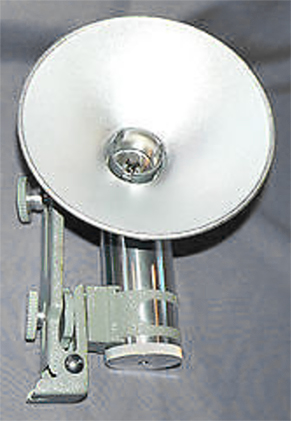
(Web images)
The unnamed flashgun in the Japanese language Yashicaflex Photography and also in the English language Yashicaflex Directions for Use Model A & C user manuals is almost certainly a Westo-Mat as well:

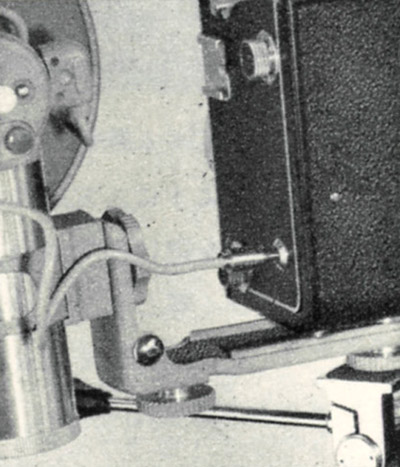
Clearly, there are obvious similarities to the Nikon BC-3 (colour, reflector and folding “L” bracket) and the Nicca BC-III (folding “L” bracket and flash head noting that there is either an offset button, or two side by side, below the white eject button):
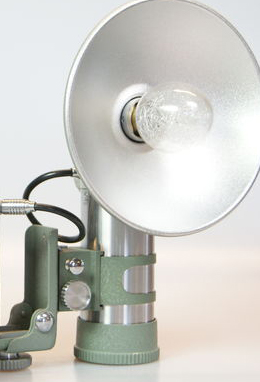
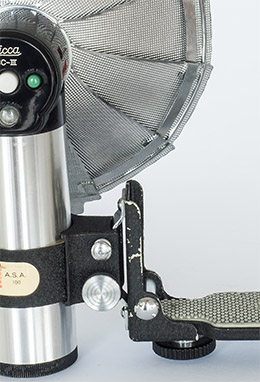
(Left detail from larger web image)
Note that the push button mount release button and locking knob are mirror reversed between the Nikon and Nicca.
Fan fold reflectors are perceived to be rather generic and similar to each other but close inspection reveals many subtle differences in design, execution, reflector patterns etc. which make them unique to their makers, bit like fingerprints. On the left, the reflector for the “West B.C.B. Miracle Power Flash Gun Type-O” mentioned earlier and on the right, the reflector for the Nicca BC-III:
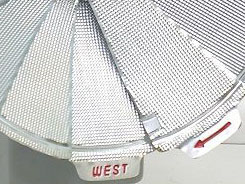
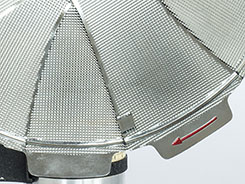
(Left detail from larger web image)
The West is a compact shoe mount type so therefore smaller. It is also quite probably newer. However, both fold in the same way, feature the same patterns and trim styles, feature the same square securing tab, the same style twin tabs on the bottom and on the back (not visible), the same style straps linking the blades together. In fact there are no real differences at all, except one is smaller with “West” on it.
Nikon B.C.B. Flashgun Development
From the Nikon history site, in the northern spring of 1950, Nippon Kōgaku's US dealers pointed out that the lack of flash synchronisation on the Nikon M rangefinder camera was a problem. The flash synchronised Nikon S was released in December 1950 together with the Nikon B.C.B. flashgun. That was a very short development period, clearly facilitated by West's involvement. The earliest Nicca would have had reason to introduce theirs was 1951 with the Nicca Type-III B but as noted on the Nicca page, September 1952 with the Nicca Type-III S was far more likely. In other words, the Nikon B.C.B. is up to two years older.
In that period, one source claims July 1952, Nippon Kōgaku updated its flashgun to the BCB-II, as identified on the user manual, although still engraved “B.C.B.”. They looked very similar, the main difference being the power supply components which resulted in a shorter tube than the original.
The earlier version was designed around D-cell size components. It could be operated with a D-cell size 22.5 volt battery and D-cell size capacitor stacked above it, two D-cells for 3 volt operation or with the extension piece, three D-cells for 4.5 volt operation.
The BCB-II was designed around smaller components. The capacitor, a little thicker than a AA/penlight battery, sits alongside a squared off battery in a special holder. The standard tube is only long enough for the holder, a bit longer than a D-cell and the end cap with spring. To use batteries without the capacitor, two options were offered; a long extension piece which allowed three D-cells to be used, or the battery/capacitor holder could be replaced with the same height battery holder for three AA cells.
Comparison of Nicca B.C.B. and Nikon BCB-II
The first thing to note is that the two are different to each other. The Nikon BCB-II is the older design of the two and is based on an even earlier design. Nicca, being a smaller company and more at the less expensive end of the spectrum than aspiring professional camera and lens maker Nippon Kōgaku, was probably more likely to accept off-the-shelf products to rebrand than Nippon Kōgaku which could be expected to look for a more bespoke solution, possibly inputting it's own design elements.
Nicca B.C.B.:

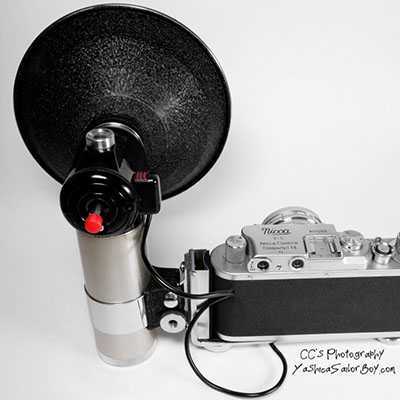
(Images courtesy of Chris Whelan)
Nikon BCB-II:
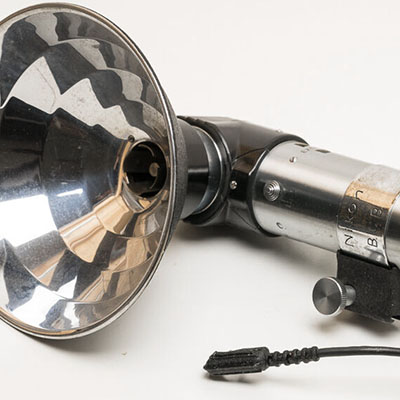
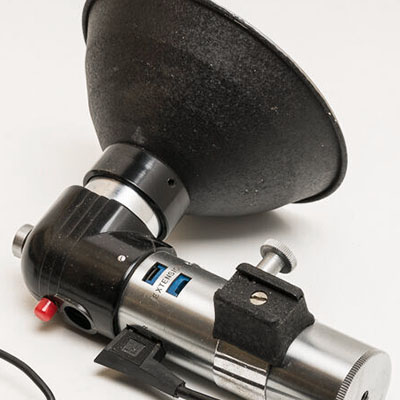
(Detail from larger web images)
OK, similarities and differences.
Fixed “L” Bracket
They're both “L” brackets, there the similarities begin and end, or so I thought. Actually, looking more closely, the basic “L” brackets are similar chromed bent steel, it's just that the Nikon is designed for the Nikon S with fixed mounting point and ads two screwed on uprights to stop the camera twisting on the bracket. The Nicca is more a universal type with two slots in the bottom to allow different cameras to be fitted. To stop its camera twisting, it has a padded end on the upright of the “L” for the camera to sit against.
Nicca on left, Nikon on right:
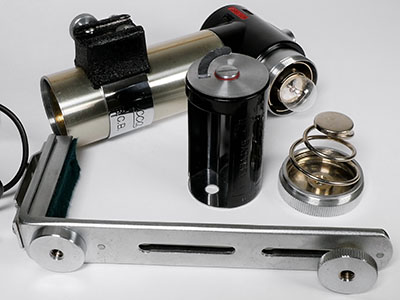
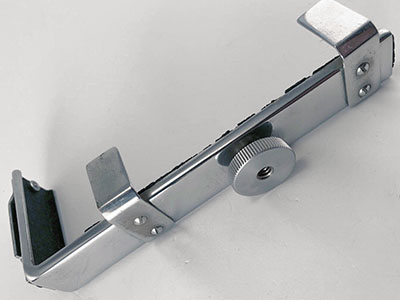
(Left image courtesy of Chris Whelan, right is from larger web image)
Both feature the same method of mounting to the tube but that is covered in the next section.
So, not really a match but maybe it's the same basic design adapted for two different design briefs?
Mounting of “L” Bracket to Tube Mount
With both the Nicca B.C.B. and BC-III, the chrome saddle below (BC-III shown) slides into a slot on the tube mount where a push button pin acts as a safety lock through the hole in the saddle. Tightening the knob below the button secures the two parts tightly.
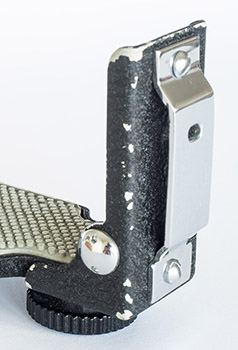
This is also the way the later Nikon BC-3 works. The saddles on the earlier Nikon B.C.B. and BCB-II flashguns look identical to this except because they don't have the push button lock, there is no hole. I have seen no other flashguns use anything similar so allowing for the missing hole on the earlier Nikons, I call this a match.
Tube Mount
Top pair of photos is a Nicca B.C.B flashgun, bottom pair is a Nikon BCB-II. Note, locking bits are on front of Nikon, on rear of Nicca. Clever, makes you think that they are different.
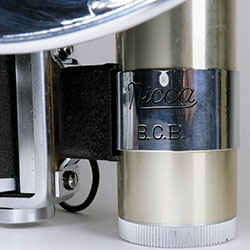
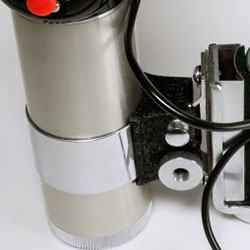
(Images courtesy of Chris Whelan)
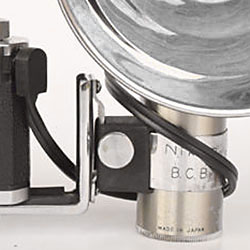
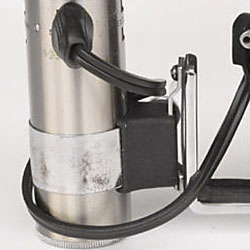
(Detail from larger web images)
As noted in the previous section, the push button safety lock didn't come to the Nikons until the BC-3, but mirror reversed or not and regardless of the different tooling on the knobs, I'm calling it a match.
Tube
The Nikon BCB-II tube is longer because like the earlier B.C.B. (longer still because of the D-cell components mentioned above), the sockets for the flash connectors are on the tube instead of on the head as with the Nicca. Maybe it was an earlier design, similar to traditional handle types, but it also allows for two pairs of extension sockets on either side of the tube as well as the pair for the shutter on the back of the tube. The Nicca B.C.B. has the shutter sockets on one side of the head and one extension pair on the opposite side. Otherwise, the tubes look the same but then again all tubes tend to. I'll call this as not a match, but then I won't mention the sockets again in regard to the flash heads below.
Flash Head
Nicca left, Nikon right.
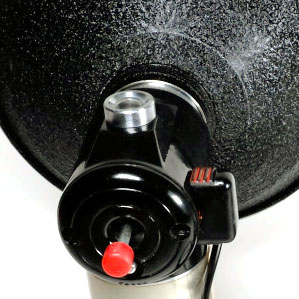

(Left image courtesy of Chris Whelan, right detail from larger web image)
Although not the same, the reflectors have a similar look and finish (better comparison above), but whereas the Nicca uses the same 5” reflector for both ES and BC bulbs, Nikon offered two sizes, a 6” for ES bulbs and 5” for BC bulbs. Niccas screw mount as does the 6” Nikon but the 5” seems to mount differently together with its BC adaptor. The very similar red eject buttons are sitting out because both have bulbs installed. On the Nikon, pressing the top lamp checks the circuit and pushing the back bulb tests the flashbulb. The Nicca top lamp/button again looks very similar but is simply described as “pilot lamp” - I don't have the complete instructions but suspect that like the BC-III, it doesn't separate the functions and tests the circuits and flash bulb as one unit. The small button just below the red eject button (almost hidden by the eject button) is for firing the flash manually (i.e., non-synch mode). So yes, they are different but they are similar too. So I'm sitting on the fence with this one.
Battery/Capacitor Holder
This is where it gets interesting. The top pair of photos are of my Nicca BC-III holder, the bottom pair from a Nikon BCB-II.
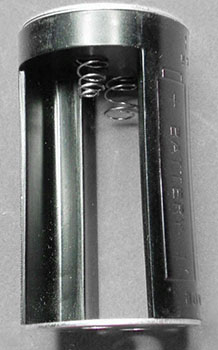
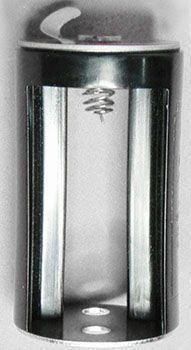 (Detail from larger web images)
(Detail from larger web images)
From many more photos showing different viewpoints, I can say that the battery/capacitor holders of the Nicca B.C.B., BC-III and Nikon BCB-II seem to me to be identical in appearance and markings. The Nikon B.C.B. doesn't use one because of its D-cell size components whilst the Nikon BC-3 is similar but more evolved with insulated plates top and bottom, a brass conducting strip down the side and grey in colour. Match.
Capacitor
Below left (blue background) is an original capacitor found with a Nicca B.C.B. flashgun. It matches the text and graphics of the capacitor in the earlier Nicca user manual schematic. The green and black background capacitors on the right found were found with Nikon flashguns, the green with a BCB-II and the black with a BC-3. They match the B&W graphic in the BCB-II user manual. The graphics and text of all three appear identical and that stretches to the D-cell type of the Nikon B.C.B. which is also has the same blue background colour as the Nicca. By the way, from the user manuals and also clues from other photos, the “FOP” on the green capacitor is clearly a misprint and the correct description is “POWER UNIT FOR B.C.B.”:
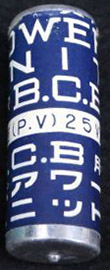
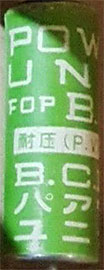
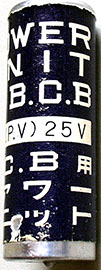 (Detail from larger web images)
(Detail from larger web images)
All the mentioned capacitors so far are clearly from the same source. It could be coincidence but it has to be viewed in terms of the other similarities too. The only flashgun that uses a different capacitor is the Nicca BC-III. This features different graphics (my one and the user manual are the same), a peak voltage of 30V instead of 25 and it says “Capacitor for B-C Flash”. It is the same physical shape and size as the three above. Match (except for the BC-III).
Optional AA/Penlight Battery Holder
Whilst mentioned in the Nicca B.C.B. user manuals, Nicca only seemed to provide the holder for three AA/penlight batteries with the earliest kit. Therefore, they are particularly rare and I have only seen two useful, low resolution, photos. Both Nicca holders were found in the red boxes marked “B-C Flash Unit for Nicca III-S model”. Nippon Kōgaku only offered the holder with the BCB-II but of the three handle type flashguns, that is the most common so I have seen photos of a few, mainly side-on but one top view to match the Nicca examples. Images 1 and 2 are the Nicca holders, Image 3 is the Nippon Kōgaku:
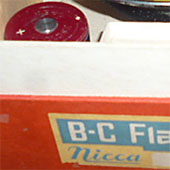
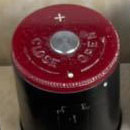
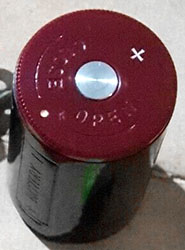 (Detail from larger web images)
(Detail from larger web images)
To the extent that I can see the detail, definitely a match.
Comparison of Nicca BC-III and Nikon BC-3
The Nicca BC-III was probably released around the same time as the Nicca Type-5 in March 1955 (it appears in the Type-5 user manual and the Type-5 appears in its manual). The Nikon BC-3 is claimed to have been released in November 1954, i.e. 3 or 4 month earlier.
First thing to note is that both have changed from “B.C.B.” to “BC” and both have a form of “3” in the model name. Both are evolutionary developments of their predecessors. In some respects they are converging, in others they are diverging e.g., the Nikon shortened its tube by finally moving the flash sync shutter and extension sockets to the head but these are now a different type to earlier and to Nicca. In the process, the screw-on tube cap was replaced by a bayonet type and the reflector is new. The head, whilst echoing the earlier style was revised with updated features, the same as Nicca did. Nippon Kōgaku also opted for a light green livery - it looks grey in some overexposed photos. There were two versions, one with the original 2 pin proprietary Nikon camera sync connector, the other with PC type for the Nikon S2. Nicca went one step further with its reflector and adopted a folding type but otherwise was more conservative with its appearance changes.
Whilst some of this pair's relevant similarities and differences have already been discussed in relation to the B.C.B. types, the two did bring two completely new similarities and the Nikon adopted a feature previously only found on the Nicca. They all relate to mounting the flash to the camera. Nicca BC-III above, Nikon BC-3 below:
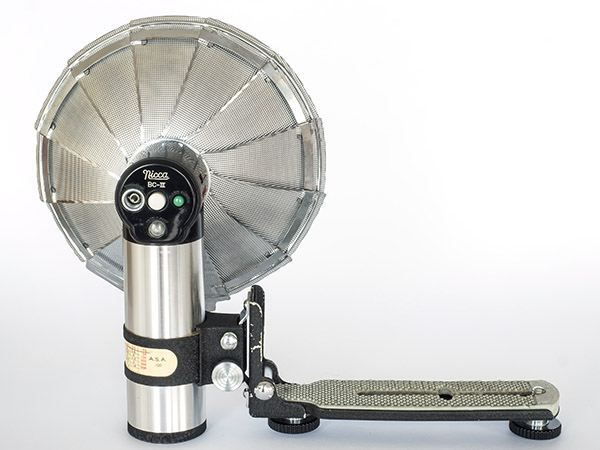
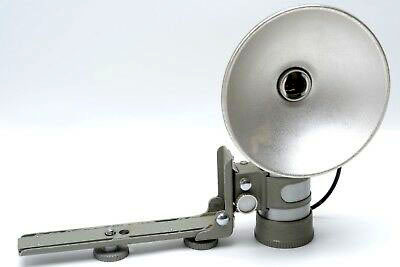
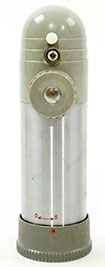 (Detail from larger web images)
(Detail from larger web images)
Both Nicca and Nippon Kōgaku moved from the early solid strap around the tube to a bare midriff type with Nicca utilising the window for a flash exposure scale. The cast mount for connecting to the “L” bracket is similar to each other and earlier types but now the Nikon has added the safety lock that was there on the Niccas from the beginning. As noted earlier, Nicca fit their locking button and knob on the back, Nippon Kōgaku on the front. As previously, the mounting saddle on the “L” bracket is the same as each other but the Nikon now also has a hole for the safety lock. And then there is the folding “L” bracket, completely new for both and adding a similarity which didn't exist for the earlier brackets.
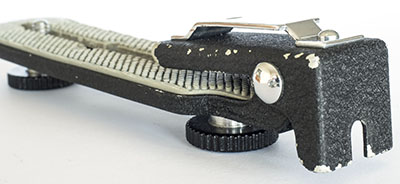
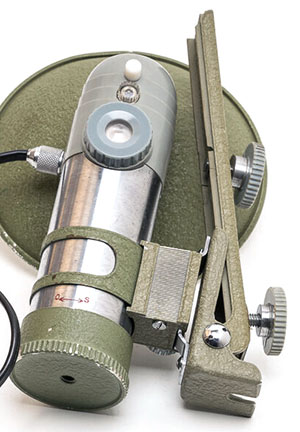
(Right detail from larger web image)
They are similar but different too. The biggest difference is in the bottom plates. The Nikon bottom plate was almost certainly specified/designed by Nippon Kōgaku to suit the Nikon rangefinder only (at the time, the S and S2). Unusually, it is narrower than the camera base plate and is also designed to be used with the camera's leather half-case attached. The retaining thumbscrew is in a fixed position suitable for the two Nikon models (it can be used on some other cameras but not Leica models or Leica copies - that was obviously not a design consideration).
On the other hand, the Nicca flash base plate seems more like a universal type. It is wider than the camera's baseplate, as most flash bracket base plates are, and the retaining thumbscrew resides in a slot allowing flexibility for mounting a number of different camera types/models. Because it is wider, the end tapers to a narrower neck to fit the same, or similar, width upright as the Nikon. The only other difference I can perceive is that on the Nicca, there is a through shaft at the pivot point whereas the Nikon utilises stub-axles. I prefer the Nicca version for a solid engineering solution but concede that the Nikon probably looks cleaner and shaves some grams from the weight, perhaps something that the narrower base plate was also designed to do.
In regard to the apparent “universal” bracket of the Nicca, the BC-III user manual also displays an optional replacement folding bracket with square base designed for “reflex” cameras, i.e. for TLRs, further implying the involvement of a specialised flash maker with a range of off-the-shelf components available. In this scenario, one would have to assume that, as already suggested, Nippon Kōgaku was aiming for a more bespoke product.
Final Comment
West made the early Nikon flashes - fact. As Nicca and West B.C.B. models share visually identical flash heads and reflectors, it follows that West almost certainly made both. With West as the maker of all the flashes, some similarities between Nicca and Nikon would be expected and even though there is visual and usability separation between the two brands, you don't have to look very hard, or deep, to find them.
